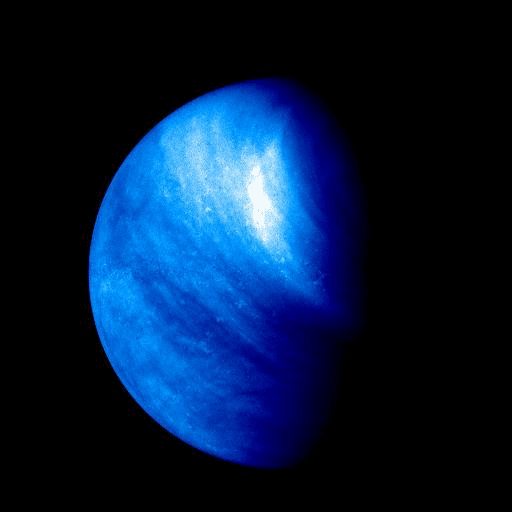[/caption]
Astronomers observing Venus back in the 1960’s discovered that the top level of Venusian cloud layers moved very rapidly, orbiting the planet in only four Earth days, compared to the planet’s own rotation of 243 Earth days. This phenomenon is called the “superotation†of Venus. The winds carrying these clouds travel at 360 km/hr, while winds at the planet’s surface are just a breeze at a few km/hr, and there have been indications that at times there’s no wind on Venus’ surface. This unique characteristics have been perplexing, but new observations carried out with ESA’s Venus Express, in orbit around Venus since April 2006, are offering insights to the planet’s atmosphere. Scientists have been able to determine in detail the global structure of the winds on Venus at the different levels of clouds while, at the same time, observe unexpected changes in the wind speeds, and which will help to interpret this mysterious phenomenon.
Venus is similar to Earth in size, and sometimes is called Earth’s sister planet. Nevertheless, it is quite different in other aspects. It’s slow rotation is also retrograde, or in the opposite direction to that of our planet, i.e. from East to West. It’s dense atmosphere of carbon dioxide with surface pressures 90 times that of Earth (equivalent to what we find at 1000 meters below the surface of our oceans), causes a runaway greenhouse effect that raises the surface temperatures up to 450ºC, to such as extent that metals like lead are in a liquid state on Venus.
At a height of between 45 km and 70 km above the surface there are dense layers of sulfuric acid clouds which totally cover the planet. Our continued explorations and observations of Venus seemed to indicate that the “superotation†was a permanent phenomenon. A team led by scientists and the University of Basque Country used images recorded by both day and night on Venus with the VIRTIS spectral camera on board the Venus Express, to measure these clouds over several months and have discovered new aspects of the “superotation.”
First, between the equator and the median latitudes of the planet there dominates a superotation with constant winds blowing from East to West. The wind speeds within the clouds decrease with height, from 370 km/h to 180 km/h. At these median latitudes, the winds decrease to a standstill at the pole, where an immense vortex forms. Other aspects of the superotation are that wind movements from north to south, or meridional, are very weak, about 15 km/h.
Second, unlike what was previously believed, the superotation appears to be not so constant over time. “We have detected fluctuations in its speed that we do not yet understand,†said the team of scientists, led by AgustÃn Sánchez Lavega. Moreover, for the first time they observed “the solar thermal tide†effect at high latitudes on Venus. “The relative movement of the Sun on the clouds and the intense heat deposited on them makes the superotation more intense at sunset than at sunriseâ€, they stated in their paper, which was published in Geophysical Research Letters.
“Despite all the data brought together, we are still not able to explain why a planet than spins so slowly has hurricane global winds that are much more intense than terrestrial ones and are, moreover, concentrated at the top of its clouds,†said Lavega. “This study has enabled advances to be made in a precise explanation of the origin of superotation in Venusian winds as well as in the knowledge of the general circulation of planetary atmospheres.”


Category 6 winds? ;p
Well, perhaps an explanation on the base of electromagnetic field generated by the Sun would make some sense. The electrically charged clouds behave as wires in the EM field of an electrical motor, so I imagine the EM field of the Sun could indeed bring them into rotation. That might also explain why the are opposite to the planet spin.
Or perhaps it is not the EM field alone, but rather the electrical current of the highly charged Solar wind that flows also through the atmosphere of Venus and electrically interacts with it, bringing it so into rotation.
Now you may ask, why then do not the clouds on Earth spin so fast too – well, unlike Venus, the Earth has its own magnetic field that shields it from the Solar wind, and prevails over the EM field of the Sun, hence its influence on the clouds is much weaker than at Venus.
shouldn’t that be “superrotation”